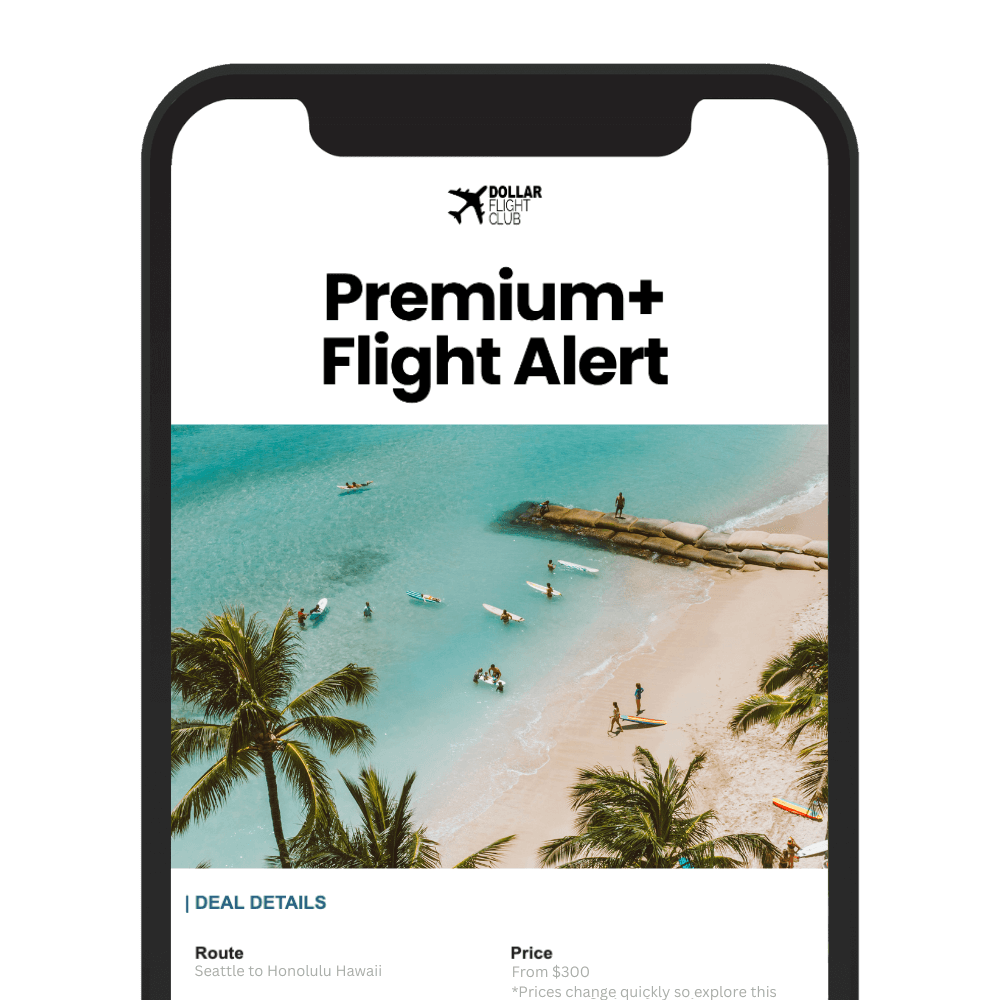Timing is everything when it comes to saving on flights. Here’s what you need to know:
- Domestic Flights: Book a few weeks in advance but avoid booking too early or too late. Prices can vary daily, so monitor fares closely.
- International Flights: Start tracking prices early, but the best time to book depends on your destination and season. Flexibility with dates helps.
- Peak Seasons: Holidays and busy travel times mean higher fares. Book early, but stay alert for rare short-term discounts.
- Cheapest Days: Flying on Tuesdays, Wednesdays, or Saturdays often costs less. Early morning or late-night flights are also cheaper.
- Tools to Save: Use flight alert services like Dollar Flight Club to track price drops or mistake fares. Price prediction tools can guide your booking decisions.
- Flexibility Pays Off: Adjusting travel dates, choosing alternate airports, or opting for layovers can reduce costs.
The key to saving is tracking trends, staying flexible, and acting quickly when deals appear. Use these tips to make smarter bookings and keep more money in your pocket.
Best Booking Windows for Domestic and International Flights
Airlines adjust ticket prices frequently, based on factors like demand, seat availability, and timing. Keeping an eye on fares can help you identify the best time to book and save money on your travels.
When to Book Domestic Flights
For domestic flights within the United States, timing is everything. Start tracking fares several weeks before your planned travel dates. Booking too early or waiting until the last minute can often lead to higher prices. Also, keep in mind that prices can vary day-to-day, so it’s worth experimenting with different departure dates to uncover potential savings.
When to Book International Flights
International travel adds another layer of complexity, with prices influenced by seasonal trends and regional demand. Begin monitoring fares as early as possible and remain flexible with your travel dates. The best time to book can vary depending on your destination and the time of year, so staying adaptable is key to snagging a good deal.
Holiday and Peak Season Booking
During holidays and peak travel seasons, airfare tends to spike. Planning ahead is critical, but airlines occasionally release short-term discounts even during these busy periods. Signing up for real-time alerts, like those from Dollar Flight Club, can help you catch these fleeting deals before they disappear.
While these tips provide a general framework, airline pricing is unpredictable. Staying flexible, actively tracking fares, and using flight deal alerts can make all the difference in finding the lowest prices. Up next, we’ll dive into how the days and times of travel can further impact airfare.

Cheapest Days and Times to Fly
When you fly can make a big difference in how much you pay. Airlines tweak their prices based on demand, so choosing less popular times to travel often means spending less.
Best Flight Times for Lower Fares
Flights that leave early in the morning (before 8 a.m.) or late at night (after 9 p.m.) are usually cheaper. On the other hand, fares tend to climb during busier travel times when demand is higher.
To snag these off-peak deals, consider setting up flight deal alerts – they can help you spot the best prices.
Next, we’ll look at how the day of the week impacts airfare.
Seasonal and Demand Trends That Affect Airfare
Knowing how travel demand fluctuates throughout the year can give you an edge when booking flights. Airlines adjust their prices based on how many people are flying, and these patterns are often tied to specific seasons and events.
High-Demand vs. Low-Demand Travel Periods
During peak travel seasons, airfare tends to skyrocket. Domestic flights are usually at their priciest during summer, winter holidays (mid-December through early January), and spring break (March to April). On the flip side, shoulder seasons – like late fall and late winter – often bring lower demand, which translates into better deals. Business travel also plays a role here, with flights on midweek business routes typically costing more due to high demand from corporate travelers.
Seasonal Pricing for Popular Destinations
Each region has its own travel trends that impact airfare. For example, European destinations are most expensive in the summer when tourists flock to enjoy the warm weather. However, traveling during the off-season can lead to significant savings. Tropical destinations like Hawaii, the Caribbean, and parts of Central America often experience two busy periods: one in winter when people seek to escape the cold and another in summer during vacation season. The most budget-friendly fares for these spots tend to pop up in the shoulder seasons, like spring or early fall.
For ski resorts, expect higher prices in winter when demand peaks, while summer brings cheaper fares. Similarly, many Asian destinations see airfare spikes during local festivals or seasonal celebrations. If you’re flexible, traveling during off-peak times can save you money, though you might have to compromise on ideal weather conditions.
To make the most of these seasonal trends, consider using tools like alert systems. For instance, Dollar Flight Club sends email and SMS notifications when airlines lower their prices, helping you snag deals during seasonal fare drops. Understanding these patterns can help you plan smarter and avoid overpaying for flights.

Tools and Strategies to Save on Airfare
When it comes to finding cheap flights, the right tools and a smart approach make all the difference. By keeping an eye on prices and staying flexible with your plans, you can consistently snag great deals and avoid paying full price for airfare. Here are some practical strategies to help you save.
Using Flight Deal Alerts and Price Monitoring
Flight alert services are a game-changer for spotting low fares. Instead of spending hours manually refreshing airline websites, these tools do the heavy lifting for you. They monitor price changes and notify you when fares drop. For example, Dollar Flight Club sends email and SMS alerts when airlines cut prices by as much as 90% off standard rates.
Airlines sometimes post mistake fares or offer flash sales that only last a few hours – deals you’d likely miss without automated alerts. These notifications give you a head start, letting you act quickly before others snatch up the bargains.
When setting up alerts, make them as specific as possible. Choose your preferred departure airports, destinations, and travel dates. Many services allow you to track multiple routes at once, so you can keep an eye on both planned trips and potential last-minute getaways. The broader your search, the better your chances of finding an unbeatable deal.
For trips planned months in advance, price tracking is especially useful. By monitoring prices over time, you’ll gain a sense of what a good deal looks like for your chosen route, helping you decide when to book.
Being Flexible with Dates and Airports
Flexibility is your best asset when it comes to saving on airfare. Even minor changes to your travel dates can lead to significant savings. For example, shifting your trip by just a few days could save you hundreds of dollars.
Certain days of the week are cheaper to fly than others. Tuesdays, Wednesdays, and Saturdays tend to have lower fares compared to high-demand days like Mondays, Thursdays, and Fridays. Business travelers often book flights on those peak days, driving up prices. If you’re willing to travel on a Saturday morning or midweek, you’ll likely find better deals.
Being flexible about airports can also pay off. Major cities often have multiple airports within a reasonable distance. For instance, travelers in the New York area can compare prices at LaGuardia, JFK, Newark, and even smaller airports like Westchester or Long Island MacArthur. Similarly, checking alternative airports near your destination could uncover cheaper options.
Timing also matters. Red-eye flights or early morning departures are often more affordable than flights during peak hours. While waking up for a 6:00 AM flight may not sound ideal, the savings can make it worth the effort. Additionally, flights with layovers are usually cheaper than direct routes, especially for longer trips or international travel.
Using Price Prediction Tools
Price prediction tools take the guesswork out of deciding when to book. These tools analyze historical data and current booking trends to forecast whether fares are likely to rise or fall in the near future. They consider factors like seasonal demand, how quickly seats are selling, and airline capacity to make educated predictions.
The biggest benefit of these tools? They help you time your booking. If a tool predicts that prices will drop, you can hold off on booking and keep monitoring. On the other hand, if prices are expected to increase, you’ll know it’s time to lock in your fare.
Keep in mind, however, that unexpected events – like weather disruptions or sudden spikes in demand – can throw off predictions. Use these tools as a guide, not a guarantee, and combine them with other strategies for the best results.

Expert Tips for Booking Flights at the Lowest Prices
Ready to save on airfare? These practical tips build on key insights about booking windows and seasonal trends to help you lock in the best deals.
Book Early, but Not Too Early
Timing is everything when booking flights. For domestic travel, aim to book several weeks in advance to snag a good rate. When it comes to international trips, avoid booking too far ahead – doing so can expose you to higher prices and potential schedule changes. Planning holiday travel? Peak times like Thanksgiving and Christmas require a different approach. As soon as your plans are confirmed, book quickly to avoid skyrocketing prices.
That said, booking too early can backfire, especially when airlines are still tweaking their schedules. Waiting until flight schedules stabilize might give you an edge.
Now, let’s talk about how flexibility with airports and routes can stretch your travel budget even further.
Consider Alternate Airports and Routes
Flying in or out of smaller, secondary airports can often save you money. Major hubs tend to charge higher fares because of their convenience and heavy demand. In contrast, secondary airports – though they might require a bit more travel time – often offer cheaper options. For instance, in cities with multiple airports, comparing fares between the main hub and smaller alternatives can reveal surprising savings.
Another strategy? Multi-city bookings. If you’re open to a stopover, breaking your trip into separate legs can sometimes be more affordable than booking a direct flight. However, steer clear of risky practices like “hidden city ticketing”, where you intentionally skip the final leg of a flight. Airlines frown on this and may penalize you.
If you live near multiple airports, consider positioning flights. For example, flying to a major hub first and then catching a competitively priced international flight from there can cut costs significantly.
Once you’ve nailed down your route, it’s time to bust some common myths about booking flights.
Common Flight Booking Myths to Avoid
Let’s clear the air about some persistent flight booking myths:
- Clearing browser cookies won’t lower fares. Prices fluctuate due to inventory, demand, and competition – not because of your browsing history.
- There’s no magic day or time to book flights. Forget the old “Tuesday at 3:00 PM” advice. Modern pricing algorithms adjust fares constantly, so focus on general trends and book within the recommended windows.
- Round-trip tickets aren’t always cheaper. While they’re often competitively priced, booking one-way tickets separately can sometimes yield savings, especially with budget airlines or when mixing carriers.
For those eyeing business class upgrades, don’t count on last-minute deals. Airlines sometimes offer discounted premium seats well in advance, so booking early is usually a safer bet than waiting for a last-minute bargain.
Finally, while airline websites may advertise exclusive deals, they don’t always have the lowest prices. Keep an eye on third-party booking platforms and deal alert services – they often highlight flash sales or mistake fares that airlines might not promote directly.

Key Takeaways for Booking Flights at the Best Prices
When it comes to scoring cheaper flights, timing and flexibility make all the difference. Here’s a quick recap of the strategies we’ve covered:
- Travel during off-peak times: Midweek flights, early mornings, late evenings, and trips during shoulder seasons often come with lower price tags.
- Be flexible: Shifting your travel dates or flying out of alternate airports can lead to better deals.
- Forget the cookie myth: Clearing your browser cookies won’t magically lower airfare prices. Also, there’s no universal “best day” to book flights.
- Use flight deal alerts: Services like Dollar Flight Club scour thousands of routes daily and notify you of significant price drops – sometimes up to 90% off. These alerts can help you snag mistake fares and limited-time flash sales that you might otherwise miss.
FAQs
How can I use flight alerts to find the best airfare deals?
Flight alert services can be a game-changer when it comes to saving money on airfare. These services let you set up notifications for your favorite routes, so you’ll know the moment prices drop. For example, platforms like Dollar Flight Club send out customized alerts for discounted flights, mistake fares, and exclusive offers – sometimes saving travelers as much as 90% on domestic and international flights.
To make the most of these alerts, keep your travel dates flexible and be ready to book as soon as a great deal pops up. Acting fast often means the difference between landing an incredible price and watching it disappear!
Should I book my flight early or wait for prices to drop?
When it comes to booking flights, timing can make all the difference. For domestic travel, the sweet spot is often 1 to 3 months before your trip, while international flights tend to offer the best deals around 50 days prior to departure.
Booking early has its perks – like better seat selection and availability, especially during busy travel seasons. But if you book too far in advance, you might end up paying more. On the flip side, waiting for last-minute deals can sometimes pay off. Just keep in mind that this approach comes with risks, such as limited options or higher prices.
If you want to save money, flexibility is key. Keep your travel dates open and monitor airfare trends closely. Watching for price drops could help you lock in a great deal before it disappears.
How do seasons and regional demand affect when to book international flights?
Seasonal patterns and regional demand heavily influence the best time to book international flights. For off-peak travel periods like late winter or fall, booking 3 to 5 months in advance is often the sweet spot, as ticket prices tend to be lower during these times. On the other hand, for high-demand seasons – think holidays like Christmas or New Year’s – it’s smarter to plan well ahead, sometimes as much as 9 months in advance, to secure the best rates.
Regional demand also plays a big role in pricing. Flights to or from major hubs often experience higher demand, which can shrink the window for snagging great deals. By keeping these trends in mind, you can time your bookings wisely and save on airfare.










